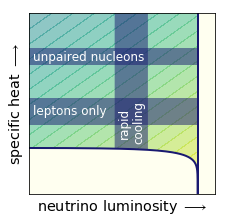
Schematic of the specific heat and neutrino luminosity for the accreting neutron star transient MXB1659-29. The known time-averaged heating of the core from accretion-induced reactions in the crust, combined with the measurement of the interior temperature, constrain the neutrino emissivity to lie in the band "rapid cooling". Observations of the heating over a single outburst constrain the specific heat to lie in the shaded region above in the upper left of the figure. Future measurements of the variation in interior temperature over a decade of cooling can further pin down the value of the specific heat. Large variations (yellow region), would imply a low specific heat, suggesting that the bulk of the nucleons are paired in a superfluid state.
Rapid Neutrino Cooling in the Neutron Star MXB 1659-29
A team of scientists has shown that observations of the accreting transient neutron star MXB 1659-29 imply that the neutrino emissivity from the neutron star core is significantly elevated compared to that of other observed cooling neutron stars. In the dense core of a neutron star, the decay of neutrons into protons and electrons is balanced by protons and electrons combining to form neutrons. Each of these reactions emits a neutrino, which escapes from the core, thereby removing energy. This process was termed the Urca process by George Gamow after a now defunct casino near Rio de Janiero—the joke being that these reactions removed heat from the star the way the casino removed money from tourists' pockets. There is a catch, however; unless there are enough protons around, the Urca process needs a bystander particle—either another proton or neutron—to conserve both momentum and energy. This drastically slows the rate of cooling. Most neutron stars are observed to cool slowly, consistent with the slower mode of cooling.
The accreting neutron star MXB 1659-29 is a transient, accreting for about 2–3 years and then cooling for about 15 years. While accreting, reactions in the outer layers of the neutron star deposit heat into the core. Observations over the last outburst/quiescent cycle have constrained the amount of heat deposited into the core and the core temperature. Brown et al. showed that the inferred low core temperature is consistent with the neutron star have a rapid cooling in the innermost few percent of the core. The neutron star in MXB 1659-29 is the first with a firmly detected thermal component in its X-ray spectrum that needs a fast neutrino cooling process.
This work was selected as an Editor's Suggestions for the journal Physical Review Letters and was featured in Physics.